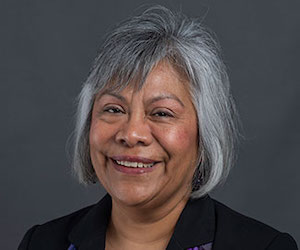Pepperdine Chapter of California Association for Bilingual Education Fosters Multicultural K–12 Learning Amid School Campus Closures
With approximately 1.2 million K–12 English learners enrolled in California public
schools, many teachers are encountering a multitude of challenges when attempting
to connect with multicultural students through the distance-learning techniques required
by the pandemic. Even with access to reliable home computers and internet service,
thousands of multicultural students are home with non-English-speaking grandparents
on weekdays while their parents work full-time jobs, which can make it more difficult
for them to log onto digital platforms like Zoom to attend classes. Such challenges
have produced unprecedented pressures for teachers to provide meaningful lessons and
educational discussions to help these particular students maintain a sense of community
during a time of isolation.
To combat these language barriers and subsequent achievement gaps, newly elected student
officers of the Pepperdine chapter of the California Association for Bilingual Education
(CABE) have joined forces with a vast network of researchers, teachers, and administrators
to develop the best quality instruction for English learners and their families. Comprising
students, alumni, staff, and faculty from the Pepperdine Graduate School of Education
and Psychology (GSEP)—the only university to establish a chapter with CABE—the group
strives to highlight multiculturalism and educational equity for the communities across
Los Angeles County and beyond through events such as conferences, professional development
workshops, and networking opportunities. “Most of the parents of English learners are also essential workers in service-based
industries, particularly in factories, fields, maintenance, and landscaping. As a
result, these parents who work all day come home tired, stressed, and unsure of how
to support their children during this time of online instruction,” explains Reyna
García Ramos, professor of education and director of the master of arts in teaching
(MAT) program at GSEP. As the faculty liaison of the association’s Pepperdine chapter,
García Ramos advises that, “Leaving a voice message, mailing a newsletter home, and
using student-teacher communication apps are key to reaching multicultural students
and parents. You have to know the community you serve and know that traditional modes
of communication do not work for our Latino English learners and their families.”
“Most of the parents of English learners are also essential workers in service-based
industries, particularly in factories, fields, maintenance, and landscaping. As a
result, these parents who work all day come home tired, stressed, and unsure of how
to support their children during this time of online instruction,” explains Reyna
García Ramos, professor of education and director of the master of arts in teaching
(MAT) program at GSEP. As the faculty liaison of the association’s Pepperdine chapter,
García Ramos advises that, “Leaving a voice message, mailing a newsletter home, and
using student-teacher communication apps are key to reaching multicultural students
and parents. You have to know the community you serve and know that traditional modes
of communication do not work for our Latino English learners and their families.”
According to the most recent California language census recorded by the California
Department of Education, nearly 42 percent of the state's students speak a language
other than English at home, 19 percent of which are English learners. In June 2020
additional surveys demonstrated that during the pandemic's academic shift from in-person
classes to virtual learning, more than 90 percent of California-based parents received
English-language information from their children’s schools about how to access digital
education platforms, 67 percent of which were unable to understand the instructions
because of language barriers. Under California’s Proposition 58, which appeared on
the state’s November 2016 general election ballots, certain school districts now offer
multilingual K–12 programs that feature instruction in seven different languages,
most commonly Mandarin and Spanish. These multilingual programs, which allow students
to learn in their home language while simultaneously becoming proficient in English,
promote the development of holistic communities and seek to diminish the linguistic
divide between older and younger generations living in the same household.
“Elementary school was tough and traumatizing for me as I learned English, and many
kids mistook my shyness and fear as unfriendliness. I even thought my teachers were
spiteful when I was unable to participate in events or practices that no one had taken
the time to explain to me,” recalls García Ramos. “In high school I thought about
being the teacher I wished I’d had when I was five, and decided to become an educator
to mentor other kids to remain positive and diligent, because these experiences leave
scars that are not easy to remove.”
Following a chaotic spring 2020, Los Angeles public schools witnessed a notable decline
in enrollment during the fall semester, with thousands of young students not showing
up for their online classes. Partially resulting from mixed messaging about whether
schools would reopen or remain closed throughout the year, this alarming rise in missing
students and their loss of education has prompted some Pepperdine MAT alumni to work
as “learning loss” teachers hired specifically to teach English learners, students
with special needs, and others that have not adapted to online instruction and are
now at risk of failing.  Linda Guzmán, principal at St. Paul Dual Language Academy in Mid-City Los Angeles,
president of the Pepperdine chapter of CABE, and current student in the education
doctoral degree program at GSEP, has connected with numerous educators in the public
and charter sectors about meeting the unique needs of bilingual students.
Linda Guzmán, principal at St. Paul Dual Language Academy in Mid-City Los Angeles,
president of the Pepperdine chapter of CABE, and current student in the education
doctoral degree program at GSEP, has connected with numerous educators in the public
and charter sectors about meeting the unique needs of bilingual students.
Guzmán, who has attended as many CABE professional development workshops as possible
over the last two years, realizes that, “As teachers we often want to believe that
everyone is equal, but the reality is that everyone has different needs, and those
needs must be addressed.” In assessing such needs, she gathers all the lessons she
learns from CABE and shares them with her faculty in order to create goals for upcoming
semesters. “Some teachers aren't sure how to support students with language barriers,
and CABE has helped us understand how to navigate that realm, especially through the
lens of servant leadership, mutual respect, social equity, human rights, and community
empowerment.”